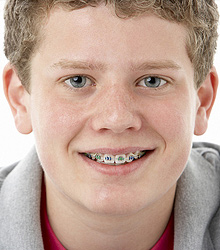Dentofacial Orthopedics
Dentofacial Orthopedics
| Common Treatments
| Surgical Orthodontics
| TMJ-TMD
| The Damon® System
In-Ovation®
| Invisalign®
| Invisalign Teen™

Understanding Orthodontics & Dentofacial Orthopedics
Orthodontics refers to tooth movement or changes in the position of the teeth. This is accomplished with braces, removable appliances or aligners.
Dentofacial Orthopedics refers to changes in the relative position of the upper or lower jaws in the face. This requires a growing patient and special appliances that can affect growing skeletal bone.
In general, what percentage of the untreated population would benefit from Orthodontics and/or Dentofacial Orthopedics?
- 2% of the population does not need either Orthodontics or Dentofacial Orthopedics. These people have good facial skeletal structure and attractive teeth that function well.
- 20% of the population have reasonably good skeletal structure and don’t need Dentofacial Orthopedics. They do need Orthodontics to have better alignment and function of the teeth.
- 75% of the population have skeletal problems that would benefit from Dentofacial Orthopedics. These people also need Orthodontics as part of their total treatment plan.
- 2% of the population have skeletal problems that either do not respond to Dentofacial Orthopedics or are too severe to be handled by means other than oral surgery to correct the skeletal relationship.
These are approximate percentages and will vary somewhat with different ethnic groups.
Teeth can be moved at any age but Dentofacial Orthopedics can only occur during skeletal growth.
If a patient who could benefit from Dentofacial Orthopedics is not seen while growing then everything changes for that patient. Now the orthodontist must choose between three choices for the patient.
- Compensation
Compensation means to treat the patient in the non corrected skeletal position with some form of compensation for the skeletal problem. Such as tipping the teeth more than normal to achieve some contact of the upper and lower teeth. Or extracting permanent teeth to allow more tooth movement since there will be less skeletal movement.
- Surgical Correction
Surgical correction means to move the skeletal parts surgically that you could have moved orthopedically.
- Compromise
Compromise means to accept in advance that you may be able to align the teeth but the upper and lower teeth will never contact as they really should.
Parents should understand if their child needs skeletal correction as part of the treatment plan to achieve the best result.
Will Dentofacial Orthopedics be used on your growing child, or will treatment involve:
- Compensation
- Surgical Correction, or
- Compromise.
The good news with Dr Jordan is that he can improve on any situation that you or your chid present with. He understands how to evaluate and explain your options and can explain treatment timing and anticipated benefits of treatment.